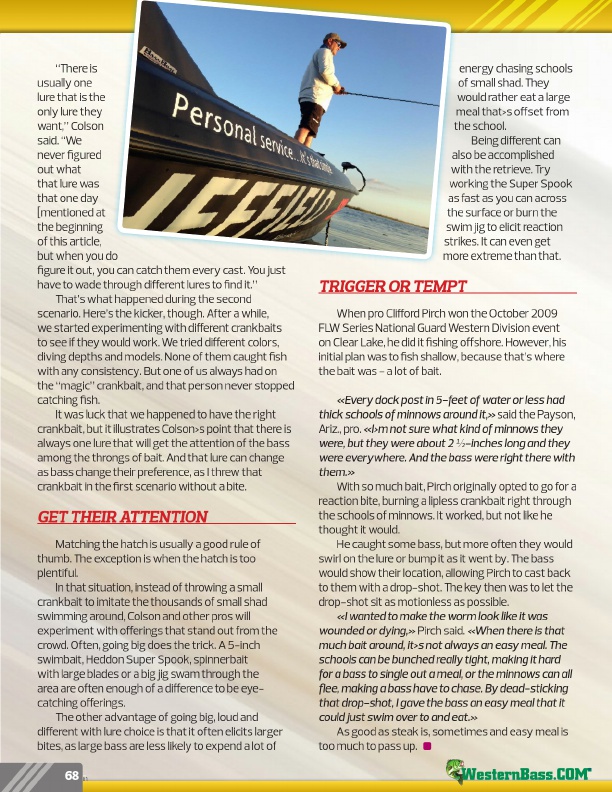
“There is usually one lure that is the only lure they want,” Colson said. “We never figured out what that lure was that one day [mentioned at the beginning of this article, but when you do figure it out, you can catch them every cast. You just have to wade through different lures to find it.”
That’s what happened during the second scenario. Here’s the kicker, though. After a while, we started experimenting with different crankbaits to see if they would work. We tried different colors, diving depths and models. None of them caught fish with any consistency. But one of us always had on the “magic” crankbait, and that person never stopped catching fish.
It was luck that we happened to have the right crankbait, but it illustrates Colson›s point that there is always one lure that will get the attention of the bass among the throngs of bait. And that lure can change as bass change their preference, as I threw that crankbait in the first scenario without a bite.
GET THEIR ATTENTION
Matching the hatch is usually a good rule of thumb. The exception is when the hatch is too plentiful.
In that situation, instead of throwing a small crankbait to imitate the thousands of small shad swimming around, Colson and other pros will experiment with offerings that stand out from the crowd. Often, going big does the trick. A 5-inch swimbait, Heddon Super Spook, spinnerbait with large blades or a big jig swam through the area are often enough of a difference to be eye- catching offerings.
The other advantage of going big, loud and different with lure choice is that it often elicits larger bites, as large bass are less likely to expend a lot of
68
energy chasing schools
of small shad. They
would rather eat a large
meal that›s offset from
the school.
Being different can
also be accomplished
with the retrieve. Try working the Super Spook as fast as you can across the surface or burn the swim jig to elicit reaction strikes. It can even get more extreme than that.
TRIGGER OR TEMPT
When pro Clifford Pirch won the October 2009 FLW Series National Guard Western Division event on Clear Lake, he did it fishing offshore. However, his initial plan was to fish shallow, because that’s where the bait was - a lot of bait.
«Every dock post in 5-feet of water or less had thick schools of minnows around it,» said the Payson, Ariz., pro. «I›m not sure what kind of minnows they were, but they were about 2 ½-inches long and they were everywhere. And the bass were right there with them.»
With so much bait, Pirch originally opted to go for a reaction bite, burning a lipless crankbait right through the schools of minnows. It worked, but not like he thought it would.
He caught some bass, but more often they would swirl on the lure or bump it as it went by. The bass would show their location, allowing Pirch to cast back to them with a drop-shot. The key then was to let the drop-shot sit as motionless as possible.
«I wanted to make the worm look like it was wounded or dying,» Pirch said. «When there is that much bait around, it›s not always an easy meal. The schools can be bunched really tight, making it hard for a bass to single out a meal, or the minnows can all flee, making a bass have to chase. By dead-sticking that drop-shot, I gave the bass an easy meal that it could just swim over to and eat.»
As good as steak is, sometimes and easy meal is too much to pass up.
®